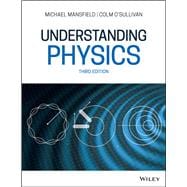An updated and thoroughly revised third edition of the foundational text offering an introduction to physics with a comprehensive interactive website
The revised and updated third edition of Understanding Physics presents a comprehensive introduction to college-level physics. Written with today's students in mind, this compact text covers the core material required within an introductory course in a clear and engaging way. The authors – noted experts on the topic – offer an understanding of the physical universe and present the mathematical tools used in physics.
The book covers all the material required in an introductory physics course. Each topic is introduced from first principles so that the text is suitable for students without a prior background in physics. At the same time the book is designed to enable students to proceed easily to subsequent courses in physics and may be used to support such courses. Relativity and quantum mechanics are introduced at an earlier stage than is usually found in introductory textbooks and are integrated with the more 'classical' material from which they have evolved.
Worked examples and links to problems, designed to be both illustrative and challenging, are included throughout. The links to over 600 problems and their solutions, as well as links to more advanced sections, interactive problems, simulations and videos may be made by typing in the URL’s which are noted throughout the text or by scanning the micro QR codes given alongside the URL’s, see: http://up.ucc.ie
This new edition of this essential text:
- Offers an introduction to the principles for each topic presented
- Presents a comprehensive yet concise introduction to physics covering a wide range of material
- Features a revised treatment of electromagnetism, specifically the more detailed treatment of electric and magnetic materials
- Puts emphasis on the relationship between microscopic and macroscopic perspectives
- Is structured as a foundation course for undergraduate students in physics, materials science and engineering
- Has been rewritten to conform with the revised definitions of SI base units which came into force in May 2019
Written for first year physics students, the revised and updated third edition of Understanding Physics offers a foundation text and interactive website for undergraduate students in physics, materials science and engineering.








